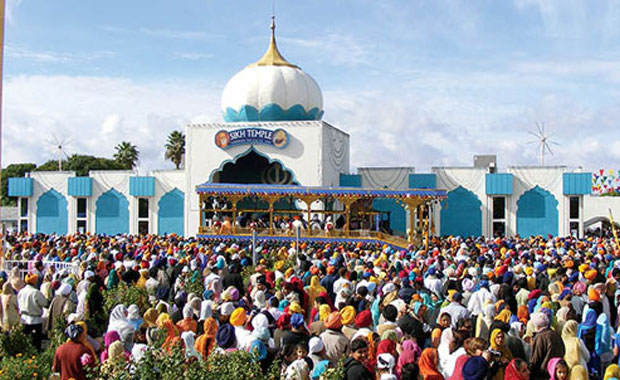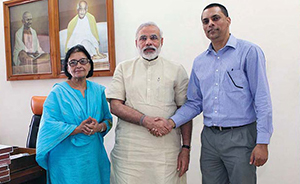Yuba City—the Mini Punjab in USA
Yuba City is well known for its annual Sikh parade which draws a large number of Sikhs from various parts of the United States, Canada, India, the United Kingdom and throughout the world. In 1969, the first Gurudwara in Yuba City was started on the 500th birth anniversary of Guru Nanak Dev, the founder of Sikh relegion. Since then, on first Sunday of November, Guru Gadi Divas (Coronation Day) of Guru Granth Sahib (Sacred Sikh Scriptures) is celebrated by
organizing a huge parade featuring many floats. The 34th annual parade in November 2013, attracted an estimated 80,000 to 100,000 people.i Two days preceding the event, the 48 hour non-stop recital of Sikh scriptures (Akhand Path) is started on Friday. After the concluding ceremony (Bhog) on Sunday, the sacred Guru Granth is ceremoniously carried onto a lavishly decorated float. As the main float leaves the Sikh Temple to lead the procession, rain of flower petals comes down from a helicopter hovering above the parade. The main float is preceded by five people dressed in orange robes, known as Panj Piare or the five Beloved of the Guru. A band of devotees continuously sweep the street in front of its path. Many Sikh groups from different parts of the United States put up their own floats which follow the lead float. Several floats have Raagi Jathas (bands of religious singers) singing hymns. All along the parade route, enthusiastic devotees put up stalls to serve free refreshments to the bystanders and passersby. Thousands of participants join the procession, many follow the floats while several thousand stand along the route and watch.
Langar (free food) is prepared for the participants gathered for this momentous occasion. Feeding of huge number of people is a major undertaking and it is done with the help of volunteers who have the spirit of Seva uppermost in their minds. As many as 200,000 meals are served during the Guru Gadi Divas weekend. There is no parallel to the event in the United States.
Yuba City looks like a typical city in Punjab on this festive occasion. All kinds of goods imported from India are sold in the Punjab Bazaar, a temporary mini shopping mall. Thus, the annual parade provides major economic benefits to the community. The city gets its share of revenue in the form of sales and other taxes. The annual event is also a homecoming weekend for many younger Sikhs who have left Yuba City for other parts of the US.
Didar Singh Bains started the parade tradition in Yuba City. He came to the US in 1958 from Nangal in Hoshiarpur and worked as a farm laborer. He and his father bought their first farm in 1962. At one time, he was one of the biggest peach growers in California and was called “Peach King of California.” He is probably the wealthiest farmer among Indians in the United States.
Yuba City has the distinction of having permanent multi-media exhibition housed in the Community Memorial Museum of Sutter County. The exhibition was developed by the Punjabi American Heritage Society and captures the story of over 100 years of the Punjabi community in the United States. The exhibit is appropriately titled, “Becoming American: The story of Pioneer Punjabis and South Asians.”
There are also large Punjabi farming communities in other cities in California such as Fresno, Bakersfield, El Centro and the areas surrounding these cities. Some of the farmers have earned name, fame and fortune. A Sikh farmer from Fresno has earned the title of “Raisin King of California.” The New York Times calls Harbhajan Singh Samra “the okra king of the USA”. Samra specializes in growing Indian vegetables such as okra, mooli, tinda, bitter melon, Indian eggplant, methi, etc. near Palm Springs, Southern California.
Many Sikhs have retained the distinguishing marks of their faith. They have invariably added to the ethnic and cultural diversity of America and have become part of the unique and distinctive multicultural character of the new society. They have contributed to the development of the region’s economy at all levels and reshaped the landscape of the cities and towns where they have their homes. At the same time, they have established themselves as a vibrant part of the society that has come to depend on their contributions in the local and national economies.
—Inder Singh regularly writes and speaks on Indian Diaspora. He is the author of The Gadar Heroics – life sketches of over 50 Gadar heroes. He is Chairman of Global Organization of People of Indian Origin (GOPIO). He was president of GOPIO from 2004-2009, president of National Federation of Indian American Associations(NFIA) from 1988-92 and chairman from 1992-96. He was founding president of Federation of Indian Associations in Southern California. He can be reached at indersingh-usa@hotmail.com











Comments.